Legs
Legs Group 1
4 sets of each (150 reps only 1 set)
Blank
Leg Extention
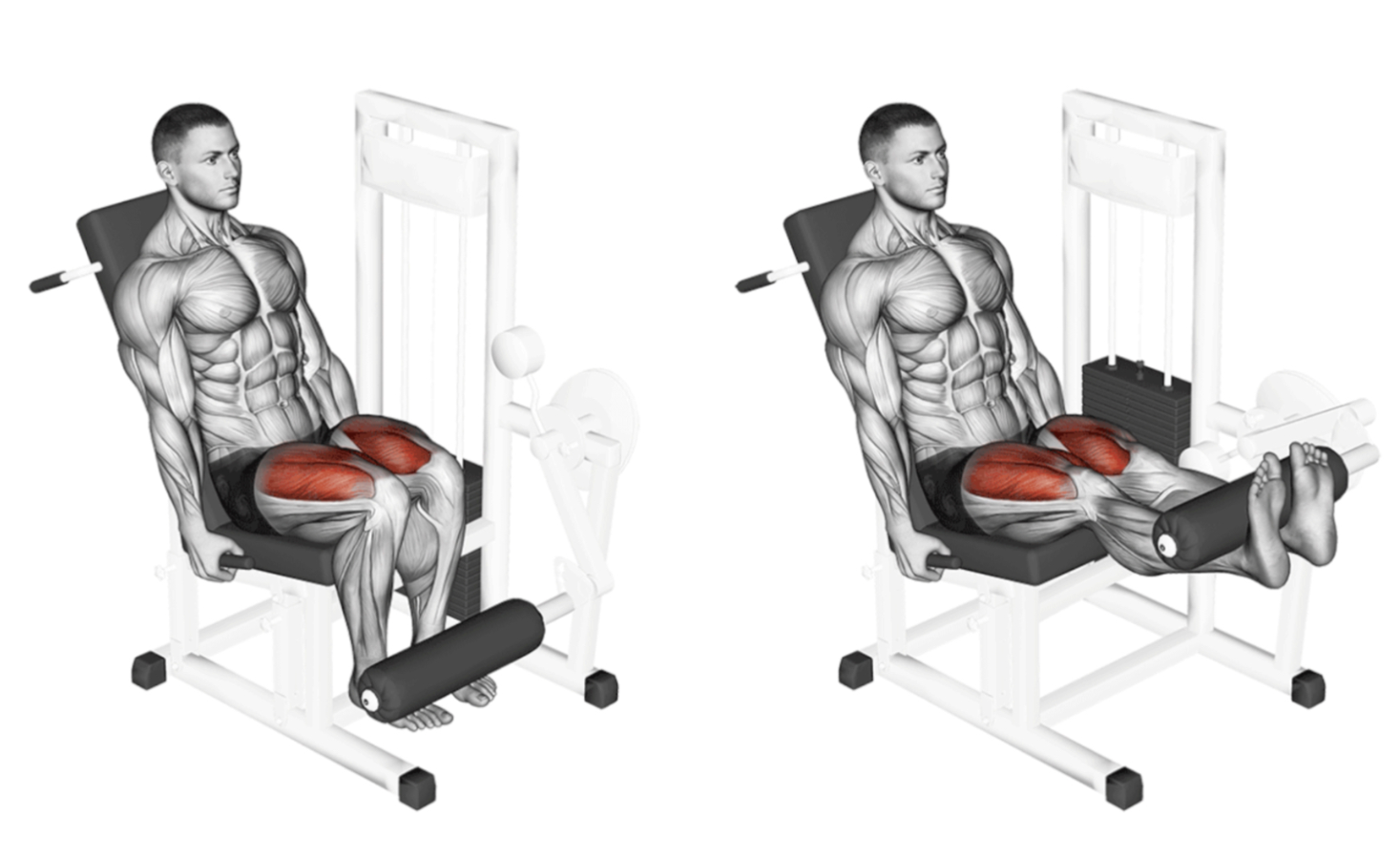
Seated Leg Extention Machine – Select intensity below:
- 15 reps (High: Strength & Build)
- 20 reps (Medium: Strength, Build & Low Endurance)
- 25 reps (Medium: Strength, Build, Endurance & Hard)
- 30 reps (Average: Strength & Build + Medium Endurance & Hard)
- 50 reps (Low: Strength & Build + High Endurance & Hard)
Leg extensions are a key exercise in strengthening the patellar ligament and quadriceps attachment for the knee. This exercise focuses on strengthening the quad alone and, therefore, strengthens key attachments for the knee joint at the same time.
Rooted in bodybuilding, leg extensions will build more muscle and assist in better muscle development. The leg extension isolates your quads, and if your goal is adding more size to your legs, you will definitely want to start using the leg extension.
Leg extensions were found to provide superior muscle growth in the rectus femoris compared to squat training. Vastus lateralis tended to grow more in the distal parts (25% and 50% of femur length) from squat training but grew more proximally (75% of femur length) from leg extensions.
Body Weight Squads
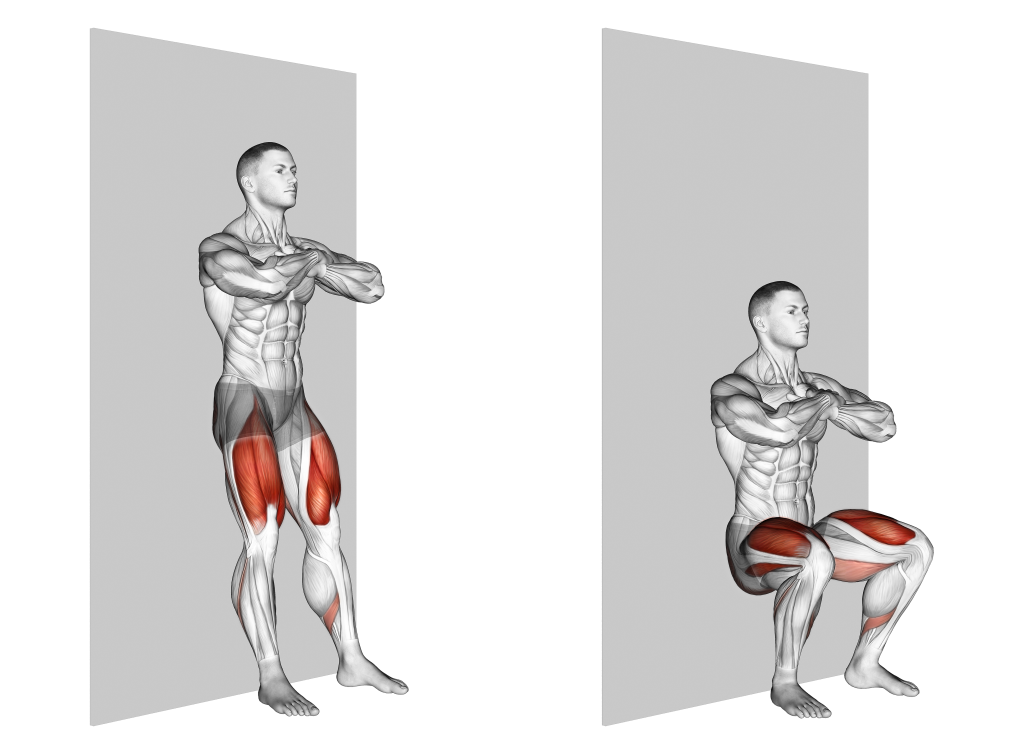
Standing – Select intensity below:
- 15 reps (High: Strength & Build)
- 20 reps (Medium: Strength, Build & Low Endurance)
- 25 reps (Medium: Strength, Build, Endurance & Hard)
- 30 reps (Average: Strength & Build + Medium Endurance & Hard)
- 50 reps (Low: Strength & Build + High Endurance & Hard)
Studies have proved that bodyweight squats enhance the strength, power, and endurance of lower body muscles. Additionally, this exercise strengthens the core, reduces the risk of injury, and helps improve mobility.
Since bodyweight squats involve multiple major muscle groups, they help you build strength and muscle throughout your entire body—especially in your legs, back, and abs.
Slow squats are better for building strength, increasing hypertrophy, practicing proper squat technique, and addressing weaknesses in the movement. But fast squats have their place, especially for those who need to improve their explosive power.
Hack Squats
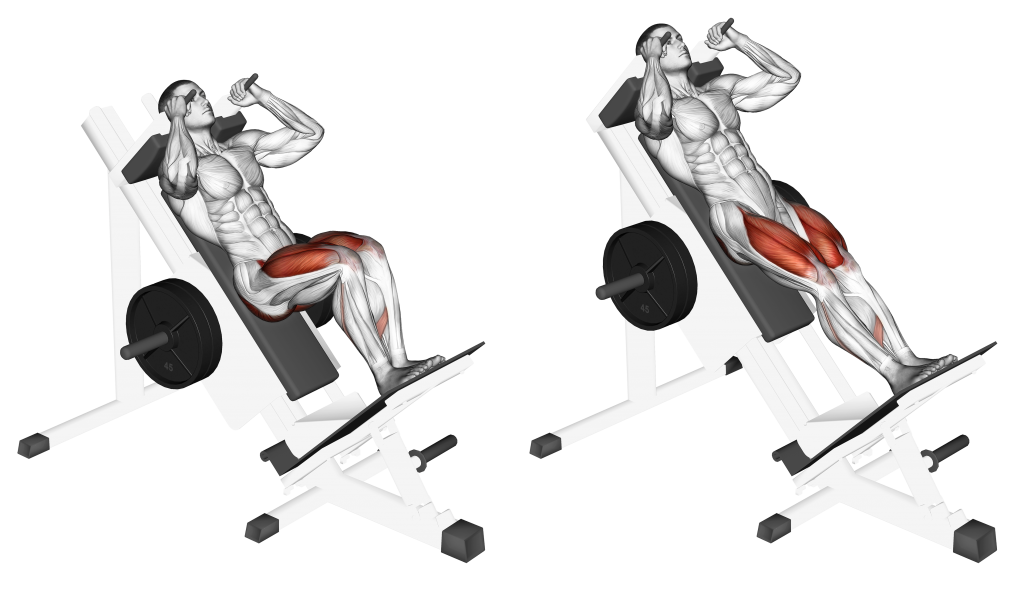
Standing Machine Squats facing forward – Select intensity below:
- 15 reps (High: Strength & Build)
- 20 reps (Medium: Strength, Build & Low Endurance)
- 25 reps (Medium: Strength, Build, Endurance & Hard)
- 30 reps (Average: Strength & Build + Medium Endurance & Hard)
- 50 reps (Low: Strength & Build + High Endurance & Hard)
A hack squat works the entire lower body — including the glutes, hamstrings, quads, and calves — as well as the core. An emphasis on the quads means the front of your legs will be feeling it afterward.
Hack squats primarily target the quads and most people are already quad dominant. Squats are a better option if you want to develop and strengthen your glutes and hamstrings.
The hack squat is generally credited to wrestler George Hackenschmidt (hence the “Hack” in the name), who designed the move to relieve the impact on the back and hips while isolating the quad muscles worked for targeted development.
The hack squat is a compound exercise that will help to increase muscle mass to the quadriceps and the glutes. To a lesser degree it also targets the hamstrings and calf muscles, but it is a very quad dominant exercise. Your foot position will also impact which muscles are worked the most.
Hack Squats Reverse

Standing Machine Squats facing Reverse – Select intensity below:
- 15 reps (High: Strength & Build)
- 20 reps (Medium: Strength, Build & Low Endurance)
- 25 reps (Medium: Strength, Build, Endurance & Hard)
- 30 reps (Average: Strength & Build + Medium Endurance & Hard)
- 50 reps (Low: Strength & Build + High Endurance & Hard)
Reverse Hack Squat works the Hamstrings and the Glutes. Set yourself under the shoulder pads of the machine with shoulder width stance. Take a deep breathe, engage your core.
The reverse hack squat is a good choice for those who may have some weaker lower backs or are returning from injury. Because the load is placed on the shoulder and follows a fixed path, the movement is easier on the back muscles when compared to the barbell back squat.
Reverse squats are incredibly effective at strengthening the hip flexors… however, they do require a good existing level of core strength. Simply lying on your back and bringing your knees to your chest can be challenging enough without any additional resistance
he Reverse Squat Strap was popularized by Ben Patrick (Knees Over Toes Guy) and his programs. According to Ben, developing strong hip flexors helps you run faster and takes stress off your knees. At the same time, the reverse squat helps to target your lower abs.
#Abs - Crunches
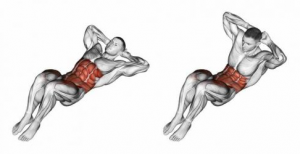
Flat Crunches – Select intensity below:
- 15 reps (High: Strength & Build)
- 20 reps (Medium: Strength, Build & Low Endurance)
- 25 reps (Medium: Strength, Build, Endurance & Hard)
- 30 reps (Average: Strength & Build + Medium Endurance & Hard)
- 50 reps (Low: Strength & Build + High Endurance & Hard)
Both situps and crunches are helpful for strengthening and developing core muscle. Over time, a stronger core can also improve your posture and reduce your risk of back injuries later in life. However, neither exercise burns fat.
Your timeline to a six-pack depends on the body fat percentage you’re starting with. A good rule of thumb (and a safe one) is to aim to lose 1 to 2 percent of body fat per month. So, unveiling your abs can take anywhere from 3 months to 2 years.
X Close All
Legs Group 2
4 sets of each (150 reps only 1 set)
Blank
Leg Press
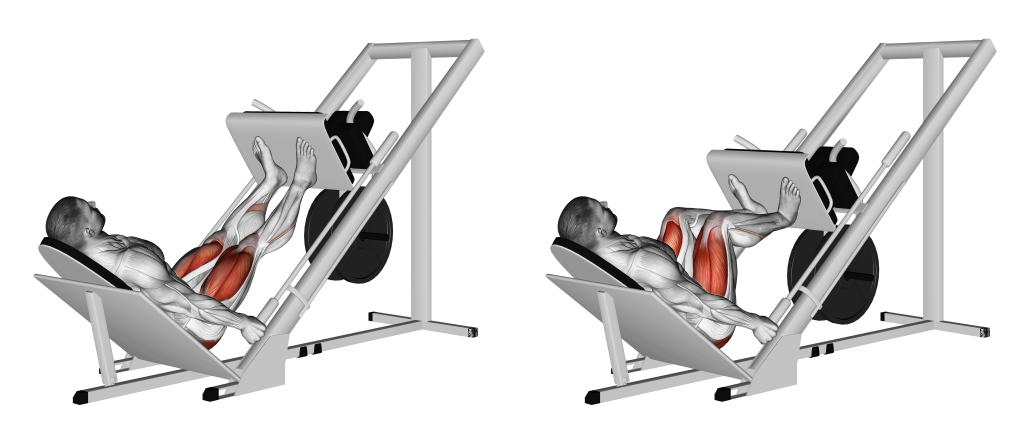
Leg Press Machine – Select intensity below:
- 15 reps (High: Strength & Build)
- 20 reps (Medium: Strength, Build & Low Endurance)
- 25 reps (Medium: Strength, Build, Endurance & Hard)
- 30 reps (Average: Strength & Build + Medium Endurance & Hard)
- 50 reps (Low: Strength & Build + High Endurance & Hard)
The leg press is the most important exercise in a workout. Regularly training with the leg press leads to strength and muscle gains in the largest muscles of the body. The leg press also improves mobility and overall physical function.
Considered a bodybuilder’s leg-building staple, alongside moves such as squats and lunges, leg presses can be an effective way to build more lower-body muscle. That being said, simply adding leg presses into your routine doesn’t automatically mean you’ll grow bigger thighs.
The leg press is one of the most simple and effective exercises for strengthening and developing the muscles in the lower body. It specifically targets the quads, hamstrings, calves, and of course, the glutes.
You can develop your fat-burning resistance by adjusting the weights you’re lifting very quickly as well. You maximise muscle growth and effective fat-loss with the leg press machine while lifting heavy weights in a safe way.
Barbell Squats
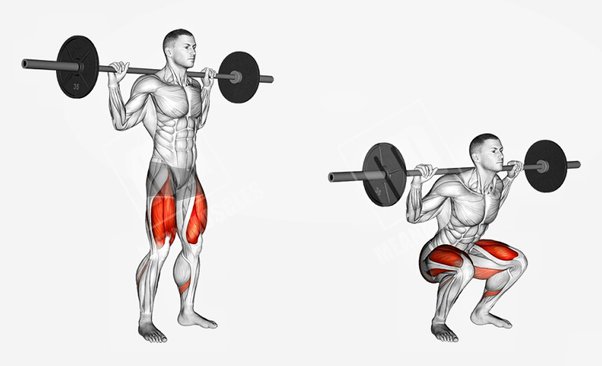
Standing Barbell Squats – Select intensity below:
- 15 reps (High: Strength & Build)
- 20 reps (Medium: Strength, Build & Low Endurance)
- 25 reps (Medium: Strength, Build, Endurance & Hard)
- 30 reps (Average: Strength & Build + Medium Endurance & Hard)
- 50 reps (Low: Strength & Build + High Endurance & Hard)
They strengthen your lower body, targeting your glutes and quadriceps. They also make you use your core muscles. Other muscles that benefit from squats are: Hip muscles.
Barbells squats are undeniably better than dumbbell squats in building lower body strength and power. The heavier weights in barbell squats greatly improve overall leg strength, including the knees and lower back. It also allows a gradual increase in weights for a more progressive overloading.
Squats work all of the glute muscles in one movement. When you strategically recruit and tax these muscles, you can trigger hypertrophy (or muscle size growth). So, yes, squats can help you build bigger glutes.
Seated Calve Raises
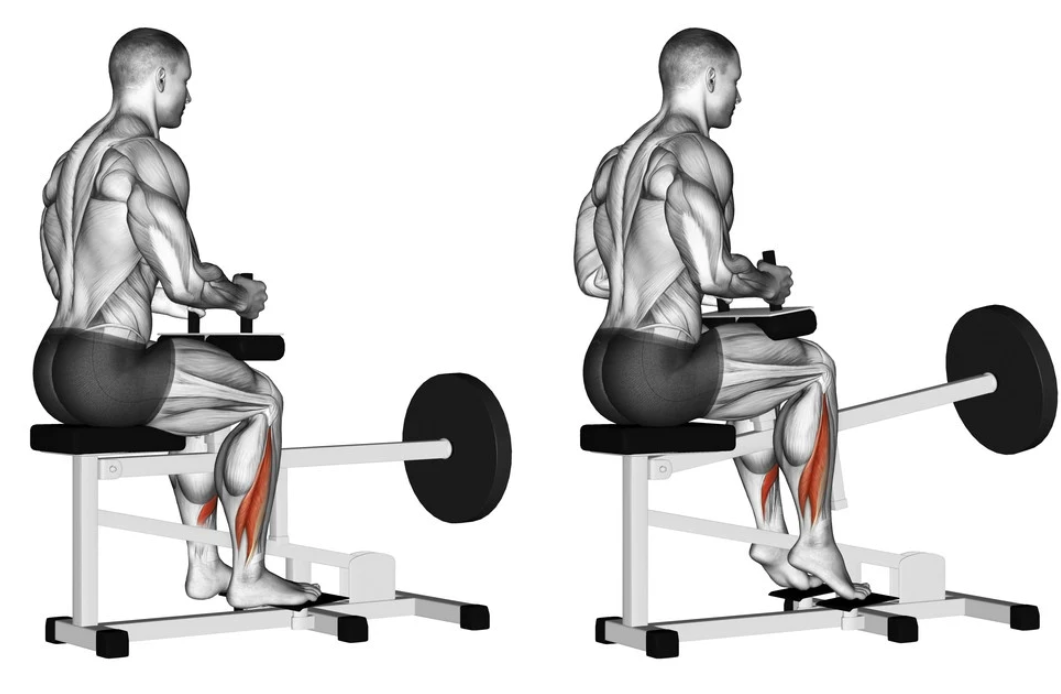
Standing Barbell Squats – Select intensity below:
- 15 reps (High: Strength & Build)
- 20 reps (Medium: Strength, Build & Low Endurance)
- 25 reps (Medium: Strength, Build, Endurance & Hard)
- 30 reps (Average: Strength & Build + Medium Endurance & Hard)
- 50 reps (Low: Strength & Build + High Endurance & Hard)
Seated calf raises are possibly the most effective soleus isolation exercise available, as they are able to recruit this difficult to target muscle at great effect, and in a full range of motion as well.
As easy as it may look, the seated calf raise strengthens the muscles that not only make you a better runner, but also support basic functions like walking and taking the stairs. The calves are one of the constantly active muscles for movement and balance.
Keep the repetitions slow and controlled. Limit momentum and pause at the top to emphasize the contraction. Limit depth of the heels if you feel any sort of stretch through the bottom of the foot during the exercise.
The ideal amount of sets and reps can vary based on the individual, but around 4 sets of 15-30 reps is a recommended.
Reps will vary depending on the weight you add, but optimal results are obtained through long sets until you feel a burn, thus via high reps. You should be doing 15-30 reps in a set and adding calf exercises into your workouts two or three times per week.
The main difference between Seated and Standing Calf Raises is that when you are doing them standing, with a straight knee, you are targeting the gastrocnemius, whereas the seated calf raises targets the soleus.
Barbell Wide Squats (Suma Squat)
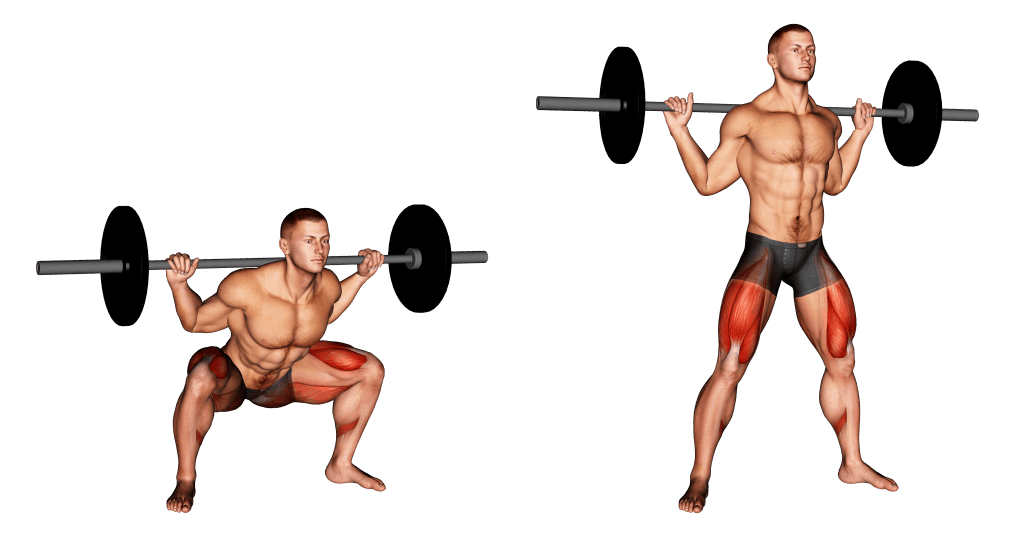
Standing Wide Feet apart Barbell Squats (Sumo Squats) – Select intensity below:
- 15 reps (High: Strength & Build)
- 20 reps (Medium: Strength, Build & Low Endurance)
- 25 reps (Medium: Strength, Build, Endurance & Hard)
- 30 reps (Average: Strength & Build + Medium Endurance & Hard)
- 50 reps (Low: Strength & Build + High Endurance & Hard)
Advantages of the wider stance squat include greater engagement of your hip musculature (glutes and hamstrings) as well as a shorter range of motion required to reach parallel. Benefits also include a reduced need for ankle mobility, and less stress being placed on your knees.
A sumo squat is excellent for targeting your glutes. A wider stance keeps your hips externally rotated to promote greater glute activation. Stand with your feet wider than shoulder width, your toes pointed slightly outward, and your hands out in front of you.
The wide stance squat provides the best option for training the hips in all three planes of motion. The wide movement exhibits greater hip flexion and smaller plantar flexion angles than narrow stance squats (1). It also produces significantly larger hip extension movements.
A wider stance activates the hips and glutes
Taking a wide stance, about 140 percent of shoulder width, forces activation of the glute, hip and hamstring muscles.
A wider stance will result in greater engagement of the muscles around the hips. The gluteal group and inner thigh muscles come alive in the wide stance version of the squat, while the quadriceps recruitment is reduced. Conversely, a narrower stance increases quadriceps recruitment and minimizes hip muscle involvement.
Step-up Bench
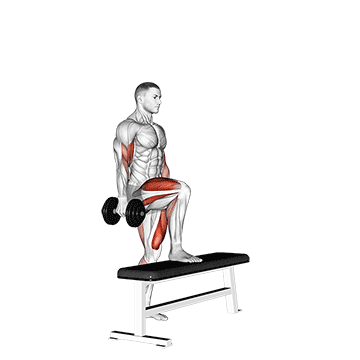
Step-ups on bench per leg – Select intensity below:
- 15 reps (High: Strength & Build)
- 20 reps (Medium: Strength, Build & Low Endurance)
- 25 reps (Medium: Strength, Build, Endurance & Hard)
- 30 reps (Average: Strength & Build + Medium Endurance & Hard)
- 50 reps (Low: Strength & Build + High Endurance & Hard)
#Abs - Hanging Leg Raises
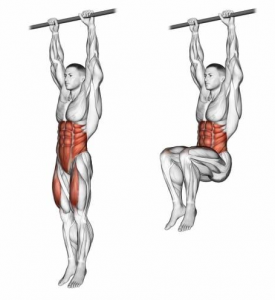
Hanging Leg Raises with or without weights – Select intensity below:
- 15 reps (High: Strength & Build)
- 20 reps (Medium: Strength, Build & Low Endurance)
- 25 reps (Medium: Strength, Build, Endurance & Hard)
- 30 reps (Average: Strength & Build + Medium Endurance & Hard)
- 50 reps (Low: Strength & Build + High Endurance & Hard)
X Close All
Legs Group 3
4 sets of each (150 reps only 1 set)
Blank
Pistol Squats
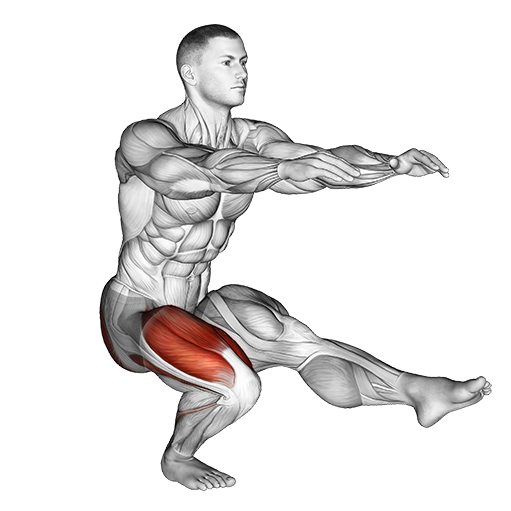
Pistol Squats per leg – Select intensity below:
- 15 reps (High: Strength & Build)
- 20 reps (Medium: Strength, Build & Low Endurance)
- 25 reps (Medium: Strength, Build, Endurance & Hard)
- 30 reps (Average: Strength & Build + Medium Endurance & Hard)
- 50 reps (Low: Strength & Build + High Endurance & Hard)
The pistol squat helps build strength in your glutes, quads, and hamstrings, as these muscles slow your descent and give you the power to return back up to standing from the bottom of your squat.
The difficulty of a pistol squat boils down to three things: strength, flexibility, and balance. You need all three in order to do a proper one. The single biggest factor you’ll need in order to use a single leg to lift your body into a standing position is strength.
The average male lifter can do 13 reps of Pistol Squat. This makes you Intermediate on Strength Level and is a very impressive achievement.
Pistol squats help build up the muscles in both your lower body and your core. They’re particularly good for working on your: glutes.
Static Lunges or Walking Lunges
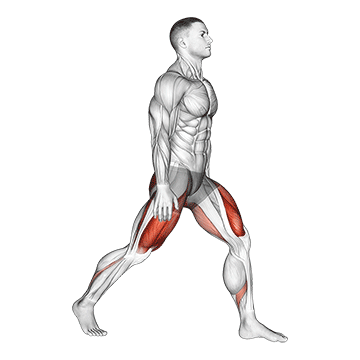
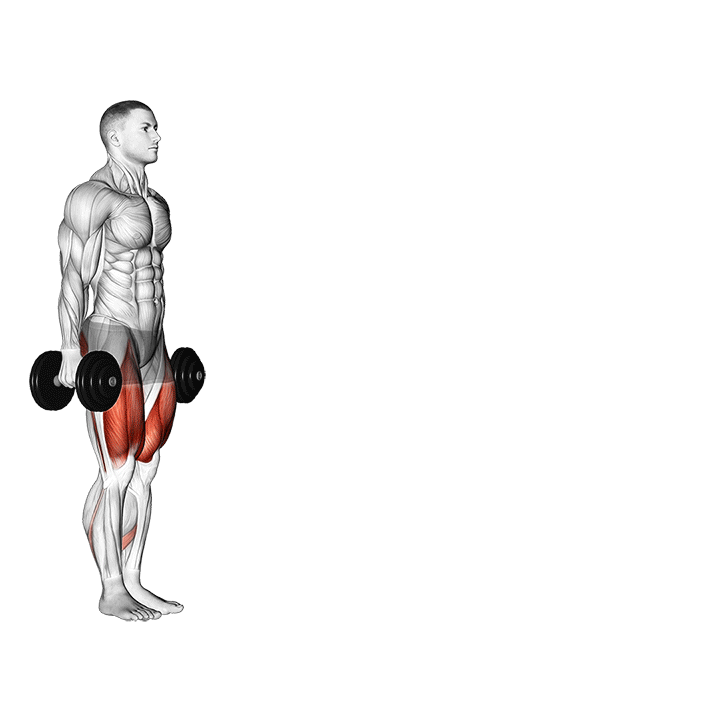
Standing Static Lunges with or without weights – Select intensity below:
- 15 reps (High: Strength & Build)
- 20 reps (Medium: Strength, Build & Low Endurance)
- 25 reps (Medium: Strength, Build, Endurance & Hard)
- 30 reps (Average: Strength & Build + Medium Endurance & Hard)
- 50 reps (Low: Strength & Build + High Endurance & Hard)
The stationary lunge has the ability to equally work the quads, hamstrings, glutes, and hip flexors to help build a stronger, more symmetrical lower body. Having equal strength on both sides can improve your bilateral performance and may help to prevent potential injury.
Stationary lunges target your glutes, quadriceps, and hamstrings. You’ll put most of your weight on your front leg and use your back leg to balance, stabilize, and support your entire body. You’ll want to get the form down since stationary lunges are the foundation for all the lunge variations.
Walking lunges put more emphasis on your front leg as you rise forward to keep walking. In contrast, stationary lunges place more emphasis on your back leg as you return to the starting position.
Lunges are great to define and shape the legs and glutes, while also improving balance, coordination, and stability.
Lying Leg Curls
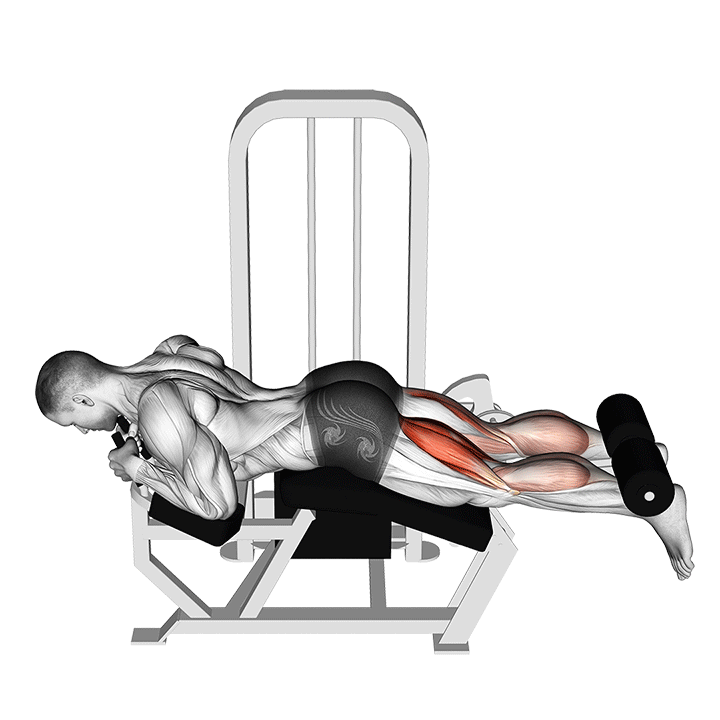
Lying Leg Curls Machine – Select intensity below:
- 15 reps (High: Strength & Build)
- 20 reps (Medium: Strength, Build & Low Endurance)
- 25 reps (Medium: Strength, Build, Endurance & Hard)
- 30 reps (Average: Strength & Build + Medium Endurance & Hard)
- 50 reps (Low: Strength & Build + High Endurance & Hard)
Step1. Exhale and flex your knees, pulling your ankles as close to your buttocks as possible. Keep your hips firmly on the bench.
Step2. Hold briefly.
Step3. Inhale as you return your feet to the starting position in a slow and controlled movement.
The lying hamstring curl is an exercise you can do with a weight machine to work the muscle in the back of the thigh. As the name implies, the lying hamstring curl targets the hamstring muscle, located here. Strong hamstring muscles help protect the knee from injury.
Lying leg curls do a better job of activating the lower hamstring muscles than the stiff-legged deadlift. However, lying leg curls are not quite as effective for building muscle size when compared to the seated leg curl.
This exercise primarily works the hamstrings, which consists of four muscles: the long head of the biceps femoris, the short head of the biceps femoris, the semimembranosus, and the semitendinosus.
Seated Leg Curls
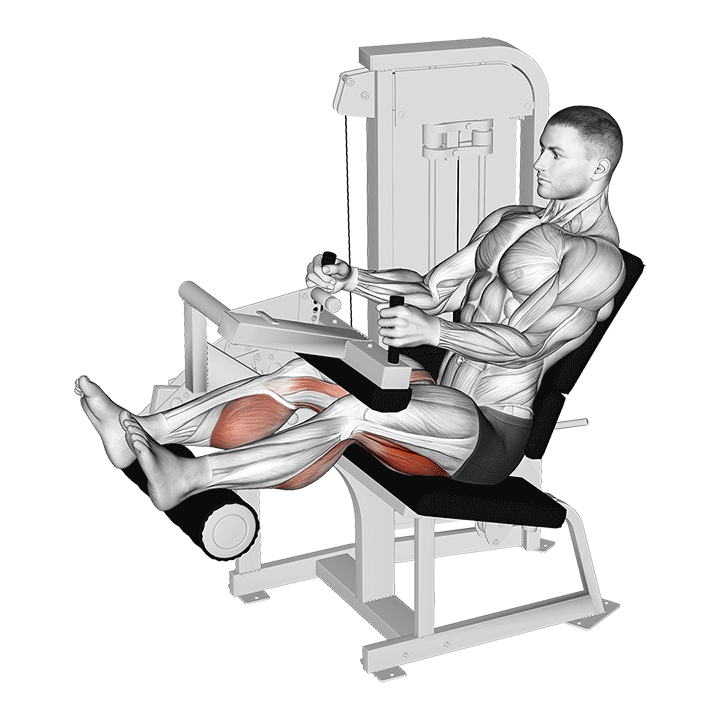
Seated Leg Curl Machine – Select intensity below:
- 15 reps (High: Strength & Build)
- 20 reps (Medium: Strength, Build & Low Endurance)
- 25 reps (Medium: Strength, Build, Endurance & Hard)
- 30 reps (Average: Strength & Build + Medium Endurance & Hard)
- 50 reps (Low: Strength & Build + High Endurance & Hard)
Take a deep breath, squeeze the hamstrings, and curl the weight up as far as possible while keeping the spine neutral. Slowly lower the weight back to the starting position and repeat for the desired number of repetitions.
Standing Calve Raises
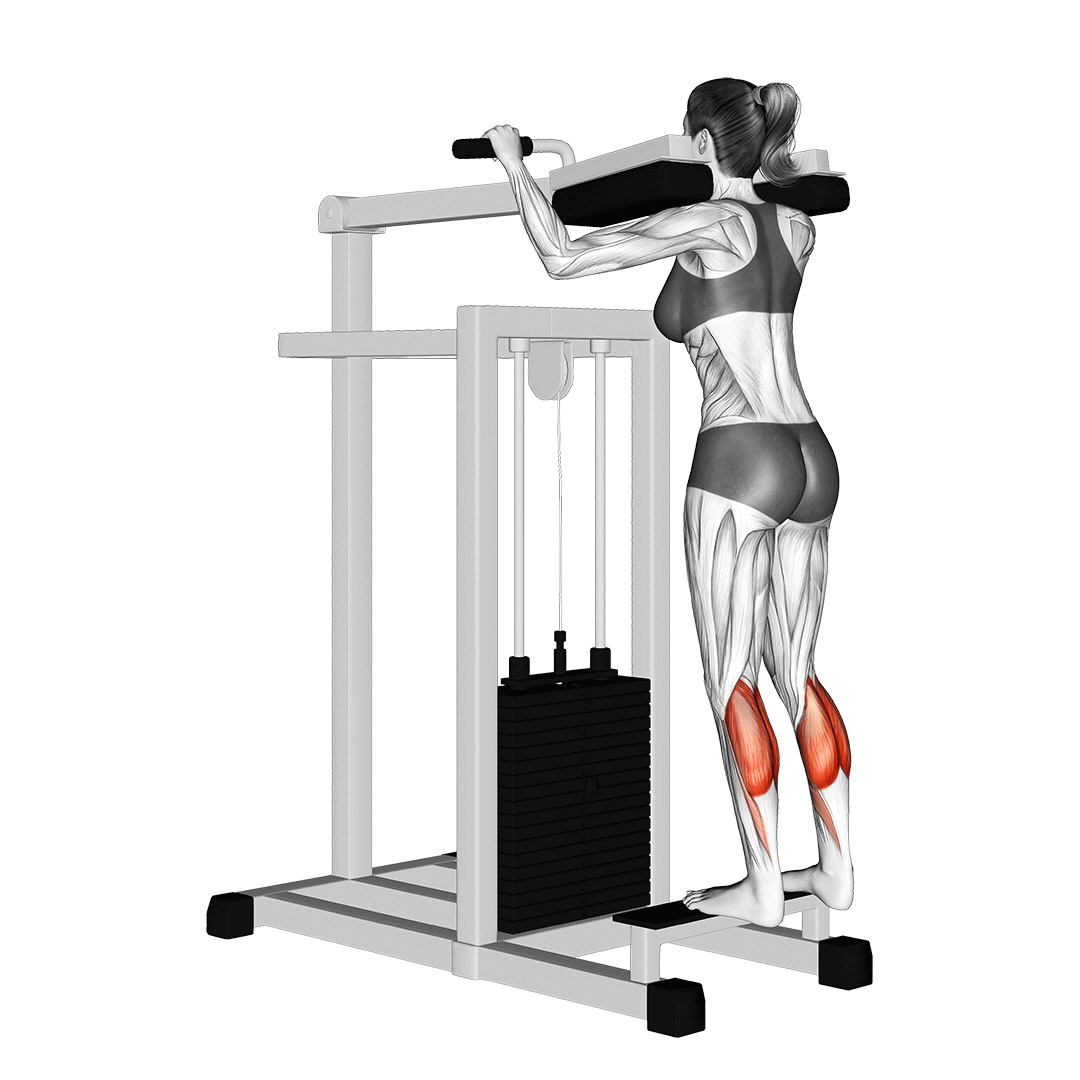
Seated Leg Curl Machine – Select intensity below:
- 15 reps (High: Strength & Build)
- 20 reps (Medium: Strength, Build & Low Endurance)
- 25 reps (Medium: Strength, Build, Endurance & Hard)
- 30 reps (Average: Strength & Build + Medium Endurance & Hard)
- 50 reps (Low: Strength & Build + High Endurance & Hard)
#Abs - Hip & Leg Raises

Lying Hip & Leg Raises – Select intensity below:
- 15 reps with Weights (High: Strength & Build)
- 20 reps (Medium: Strength, Build & Low Endurance)
- 25 reps (Medium: Strength, Build, Endurance & Hard)
- 30 reps (Average: Strength & Build + Medium Endurance & Hard)
- 50 reps (Low: Strength & Build + High Endurance & Hard)
X Close All
Weight Training
5 Days a week
Cardio Workout
2 x 5km Runs per week
4 x 30min Cycle per week
Agility Training
5 days a week
Meal Planning
6 days meal plan and day 7 cheat meal day